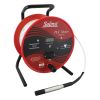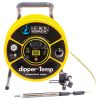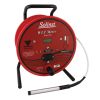Heron conductivity plus Water Level Meters
Features
- High-tensile steel core tape, tested for stretch resistance to ASME standards
- 4-electrode conductivity probe displays values up to 80,000 micro-siemens
- Probe is 7/8" diameter x 5.5" long (2.2cm x 14cm)
- Free ground shipping
- Expedited repair and warranty service
- Lifetime technical support
- More
Overview
The Heron conductivity plus Level and Temperature Meter accurately measures conductivity, water level and temperature in wells, boreholes, stand pipes and open bodies of water. The meter can be used to profile conductivity and temperature to depths of 1000 ft (300m).
Design
The Heron conductivity plus uses a measuring tape with a high tensile steel core, tested for stretch resistance to ASME standards. Two seven strand stainless steel conductors add to the strength of the tape. The tape graduations are in decimal feet with markings at each 1/100th foot or metric with markings at each mm.
A super bright red LED and an 80dB buzzer are also housed in the module. The electronics are based on A/C current, helping prevent probe corrosion and fouling. All electronics are protected from dust and moisture by an epoxy-based conformal coating. The unit is powered by a single 9V battery also housed within the module. The standalone, sturdy steel frame is coated in Polyurethane for durability, and the vinyl-coated carry handle is ergonomically designed for comfort and easier rewinding.
Mechanics
The probe utilizes a four-electrode system comprising of two arrays of a single electrode within a concentric electrode. Water level is sensed when the probe passes from a non-conductive medium (air) to a conductive medium (water). The meter measures the temperature and automatically converts readings to specific conductivity values. Calibration is easy using readily-available 1413us solution. The electronics module houses an LCD screen which displays conductivity values up to 80,000 micro-siemens and a temperature range from 0 C to +50 C.
- Premium Stainless Steel Polyethylene Coated Tape
- 7/8” (22.2mm) Conductivity Probe (IP68) w/ holder
- Electronic Panel with audio and visual signals (Fully Encapsulated to IP65)
- High Contrast LCD Display
- Vinyl, ergonomic holding grip
- 9V Battery
- Backpack Carrying Case w/ adjustable straps, laptop & notepad pouches
- 1 x 1413μ S Conductivity Solution
In The News
Spring 2025 Environmental Monitor Available Now
In the Spring 2025 edition of the Environmental Monitor, we highlight partnerships across the world and the importance of collaboration between government agencies, universities, environmental groups, local communities, and other stakeholders. From great white shark research in Cape Cod to monitoring fisheries in Lake Erie, this latest edition underscores partnerships that connect stakeholders in a watershed through environmental data. With an emphasis on data sharing, a combination of real-time and discrete sampling keeps the public and partners informed of environmental conditions. Our writers also sought out science professionals dedicated to working with peers within and outside of the environmental sector.
Read MoreMonitoring Mariculture in the Gulf of Alaska
The mariculture industry in the Gulf of Alaska has been steadily growing in recent years, guided by ongoing research to help refine farm location and cultivation practices. A subset of aquaculture, mariculture focuses on rearing organisms in the open ocean. In Alaska, finfish farming is illegal, so most farms cultivate kelp, oysters, or a combination of the two. These small, locally operated farms started popping up in the Gulf of Alaska in the early 1990s, when shellfish farming first became legal. Kelp farming did not begin to catch on in the state until 2016. Many of the coastal areas that have grown interested in mariculture are historically commercial fishing communities.
Read MoreSupplying Seattle’s Drinking Water: Using Data Buoys to Monitor the Cedar River Municipal Watershed
Providing clean, safe, and reliable drinking water for the 1.6 million people in the greater Seattle area is a top priority for Seattle Public Utilities (SPU). With limited water supplies, SPU dedicates considerable resources to maintain its watersheds and mountain reservoirs. About 70 percent of Seattle Water comes from the Cedar River Municipal Watershed , and the other 30 percent comes from the South Fork Tolt River Watershed . [caption id="attachment_39574" align="alignnone" width="940"] Data buoy in Chester Morse Lake . (Credit: Kevin Johnson / Seattle Public Utilities) [/caption] Jamie Thompson, a fisheries biologist at SPU, monitors aquatic ecosystems centered on fish listed under the U.S. Endangered Species Act (ESA).
Read More






















